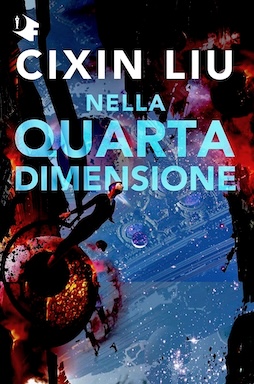“Nella quarta dimensione” è il terzo capitolo della saga “Il problema dei tre corpi” di Cixin Liu, conosciuta anche come la trilogia “Memoria del passato della Terra” (primo capito “Il problema dei tre corpi“, secondo capitolo “La materia del cosmo“). In questo libro, Liu continua a esplorare temi complessi di fisica, sociologia, e filosofia attraverso una narrazione avvincente e ricca di colpi di scena.
Il libro segue le conseguenze delle azioni dei personaggi dei capitoli precedenti, concentrandosi sull’interazione tra umanità e Trisolariani, una civiltà aliena in rotta di collisione con la Terra. La trama è caratterizzata da una tensione crescente man mano che l’umanità tenta di prepararsi per l’imminente invasione aliena. Nel terzo capitolo della saga, vengono introdotti nuovi personaggi e vengono approfondite le motivazioni e le strategie di entrambe le parti.
Ecco alcuni dei punti salienti del terzo capitolo della saga:
- Continuazione della Guerra Culturale e Militare: La tensione tra umanità e Trisolariani continua a crescere, con entrambi i lati che cercano vantaggi strategici. La guerra non è solo combattuta con mezzi militari, ma anche attraverso la propaganda e la manipolazione psicologica.
- Tecnologia Avanzata e Scoperte Scientifiche: Come nei capitoli precedenti, la scienza e la tecnologia giocano un ruolo cruciale. Vengono esplorati concetti avanzati di fisica e matematica, con particolare enfasi sulla teoria delle dimensioni extra e sulla possibilità di viaggi interdimensionali.
- Personaggi Complessi e Sviluppo delle Loro Storie: Liu continua a sviluppare i suoi personaggi in modo profondo e realistico. Le loro storie personali e le loro scelte morali sono intrecciate con gli eventi su scala globale e cosmica.
- Temi Filosofici e Esistenziali: Il libro esplora domande profonde sulla natura dell’esistenza, sul destino dell’umanità e sul significato della vita in un universo ostile. Questi temi sono trattati attraverso la lente della fantascienza, rendendo la narrazione sia intellettualmente stimolante che emotivamente coinvolgente.
- Scenari Epici e Ambientazioni Fantascientifiche: Il libro offre descrizioni dettagliate di ambientazioni futuristiche e scenari epici, che vanno dalla Terra devastata dalla guerra a mondi alieni straordinari.
In sintesi, “Nella quarta dimensione” continua a costruire sulla base solida dei libri precedenti, espandendo la trama e approfondendo i temi centrali della saga. È un capitolo essenziale per comprendere l’evoluzione della storia e i destini dei suoi personaggi principali.
English Version
“In the Fourth Dimension” is the third chapter of Cixin Liu’s “The Three-Body Problem” series, also known as the “Remembrance of Earth’s Past” trilogy. In this book, Liu continues to explore complex themes of physics, sociology, and philosophy through a compelling and twist-filled narrative.
The book follows the consequences of the actions of the characters from the previous chapters, focusing on the interaction between humanity and the Trisolarans, an alien civilization on a collision course with Earth. The plot is characterized by increasing tension as humanity attempts to prepare for the impending alien invasion. In the third chapter of the saga, new characters are introduced, and the motivations and strategies of both sides are further explored.
Here are some highlights of the third chapter of the saga:
- Continuation of Cultural and Military War: The tension between humanity and the Trisolarans continues to grow, with both sides seeking strategic advantages. The war is fought not only through military means but also through propaganda and psychological manipulation.
- Advanced Technology and Scientific Discoveries: As in the previous chapters, science and technology play a crucial role. Advanced concepts of physics and mathematics are explored, with particular emphasis on the theory of extra dimensions and the possibility of interdimensional travel.
- Complex Characters and Their Stories: Liu continues to develop his characters in a deep and realistic way. Their personal stories and moral choices are intertwined with events on a global and cosmic scale.
- Philosophical and Existential Themes: The book explores profound questions about the nature of existence, the fate of humanity, and the meaning of life in a hostile universe. These themes are addressed through the lens of science fiction, making the narrative both intellectually stimulating and emotionally engaging.
- Epic Scenarios and Sci-Fi Settings: The book offers detailed descriptions of futuristic settings and epic scenarios, ranging from a war-torn Earth to extraordinary alien worlds.
In summary, “In the Fourth Dimension” continues to build on the solid foundation of the previous books, expanding the plot and deepening the central themes of the saga. It is an essential chapter for understanding the evolution of the story and the fates of its main characters.
